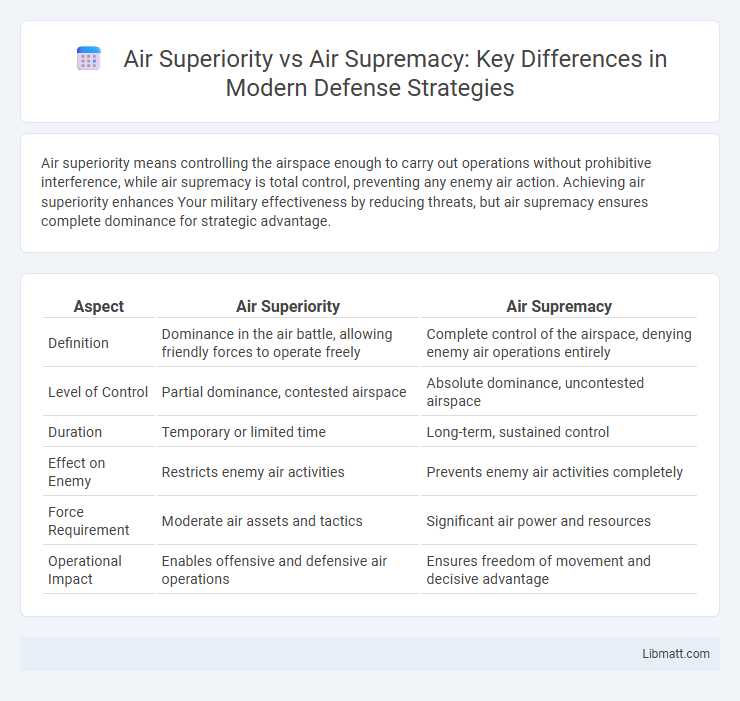Air superiority means controlling the airspace enough to carry out operations without prohibitive interference, while air supremacy is total control, preventing any enemy air action. Achieving air superiority enhances Your military effectiveness by reducing threats, but air supremacy ensures complete dominance for strategic advantage.
Table of Comparison
| Aspect | Air Superiority | Air Supremacy |
|---|---|---|
| Definition | Dominance in the air battle, allowing friendly forces to operate freely | Complete control of the airspace, denying enemy air operations entirely |
| Level of Control | Partial dominance, contested airspace | Absolute dominance, uncontested airspace |
| Duration | Temporary or limited time | Long-term, sustained control |
| Effect on Enemy | Restricts enemy air activities | Prevents enemy air activities completely |
| Force Requirement | Moderate air assets and tactics | Significant air power and resources |
| Operational Impact | Enables offensive and defensive air operations | Ensures freedom of movement and decisive advantage |
Defining Air Superiority and Air Supremacy
Air superiority refers to the condition where one force holds control over the airspace, allowing friendly operations without significant interference from the enemy. Air supremacy goes beyond this, indicating complete dominance where opposing forces are incapable of effective resistance or challenge in the air. Achieving air supremacy ensures Your military operations face minimal threats from hostile aircraft and air defenses.
Historical Evolution of Control in the Skies
The historical evolution of air superiority and air supremacy reflects the shifting tactics and technology from World War I's rudimentary dogfights to today's advanced stealth and network-centric warfare. World War II marked the first large-scale contest for air superiority with battles like the Battle of Britain demonstrating control of the skies as crucial to overall military success. Modern doctrines emphasize air supremacy as complete and uncontested dominance of the airspace, achieved through integrated air defense suppression and precision strike capabilities, evolving from earlier concepts of merely gaining local or temporary superiority.
Key Strategic Differences
Air superiority refers to the degree of dominance in the air battle that allows friendly forces to conduct operations without prohibitive interference from enemy air forces, whereas air supremacy represents complete control of the airspace, effectively eliminating adversary air threats. The key strategic difference lies in the level of control: air superiority provides a competitive advantage, while air supremacy ensures unchallenged freedom of action and the ability to support joint operations decisively. Achieving air supremacy often requires a comprehensive and sustained campaign involving advanced fighter aircraft, electronic warfare, and integrated air defense suppression.
Technological Advancements Shaping Air Dominance
Technological advancements such as stealth technology, advanced radar systems, and precision-guided munitions have significantly shifted the balance between air superiority and air supremacy. Air superiority ensures control of the skies to support friendly operations, while air supremacy achieves near-total dominance, eliminating enemy air threats. Your ability to leverage cutting-edge innovations like unmanned aerial vehicles and AI-driven combat systems can decisively enhance air dominance in modern warfare.
Notable Conflicts Illustrating the Concepts
The Battle of Britain during World War II exemplifies air superiority, where the Royal Air Force successfully defended the UK by limiting the Luftwaffe's operational effectiveness without total control of the skies. In contrast, U.S. air operations during the Gulf War exhibit air supremacy, achieving near-complete dominance over Iraqi air forces, allowing unchallenged freedom of action for coalition forces. Your understanding of air warfare can be enriched by studying these conflicts, highlighting how varying levels of aerial control impact military strategy and outcomes.
Doctrinal Approaches of Major Air Forces
Major air forces such as the U.S. Air Force and the Royal Air Force distinguish between air superiority and air supremacy through nuanced doctrinal approaches. Air superiority denotes the state where friendly forces hold a significant advantage in the air battle, allowing effective missions despite enemy resistance, while air supremacy signifies complete control with negligible enemy interference. Doctrine emphasizes achieving air superiority as a prerequisite for broader operational success, with strategies focused on dynamic, layered air defense suppression and precision strike capabilities to transition toward air supremacy in contested environments.
Role of Intelligence and Electronic Warfare
Intelligence and electronic warfare play pivotal roles in achieving air superiority and air supremacy by enabling real-time threat detection and disruption of enemy communications. Advanced signal intelligence (SIGINT) and electronic attack (EA) systems degrade adversary radar and command capabilities, tipping the balance in contested airspace. Superior situational awareness derived from these technologies ensures dominance over enemy air forces, facilitating control of the skies and operational freedom for allied assets.
Challenges in Achieving Complete Air Supremacy
Achieving complete air supremacy involves overcoming significant challenges such as advanced enemy air defense systems, including surface-to-air missiles and radar capabilities, which limit freedom of operation. The complexity of coordinated electronic warfare and stealth technology requires continuous innovation to detect and neutralize threats in diverse and contested environments. Maintaining air superiority demands persistent intelligence, surveillance, and reconnaissance (ISR) capabilities alongside rapid deployment of multi-domain forces to counter evolving aerial threats.
Future Trends in Aerial Warfare
Air superiority ensures control of the skies, limiting enemy air operations, while air supremacy establishes near-total dominance, allowing unrestricted air action. Future trends in aerial warfare emphasize advanced stealth technology, autonomous drones, and integrated AI systems to shift the balance towards achieving air supremacy more efficiently. Your air strategy will increasingly rely on networked platforms and electronic warfare to maintain an edge in contested environments.
Implications for Modern Military Strategy
Air superiority ensures control over enemy airspace for specific operations, while air supremacy guarantees near-total dominance, preventing enemy air intervention altogether. Modern military strategy increasingly prioritizes air supremacy to enable unchallenged surveillance, precision strikes, and rapid troop movement, minimizing risk to ground forces. Your ability to achieve air supremacy can decisively influence the success of combined arms operations and overall battlefield dominance.
Air superiority vs Air supremacy Infographic

 libmatt.com
libmatt.com